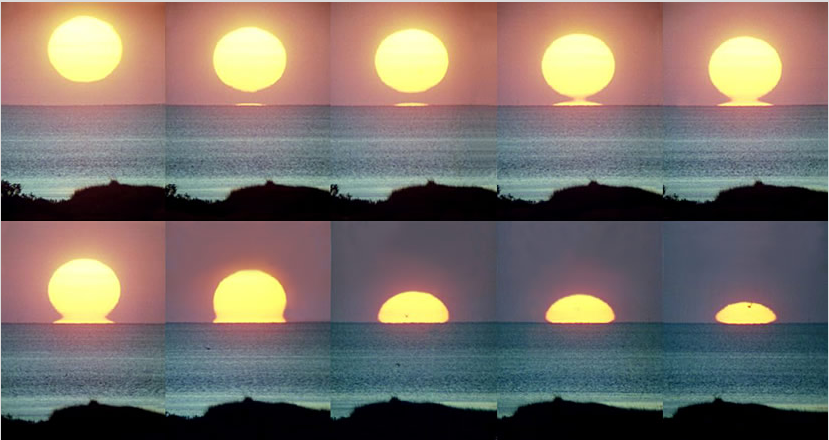Etruscan Vase or "Omega" Sunsets
Etruscan Vase or "Omega" Sunsets: A Breathtaking Phenomenon
Sunsets have long captivated us with their stunning beauty and mesmerizing colors. But there is one particular atmospheric optics phenomenon that adds an extra layer of wonder to these natural spectacles: the Etruscan Vase or "Omega" sunset. This captivating display occurs when the setting sun appears to split into two distinct orbs, resembling an ancient Etruscan vase or the Greek letter omega.
As the sun begins its descent below the horizon, a second sun seemingly emerges from the water, creating a surreal and awe-inspiring sight. Gradually, these two suns converge, forming a vertically stretched "stem" that emanates a vibrant red hue. The visual resemblance to an Etruscan vase, as noted by Jules Verne, adds a touch of historical mystique to this already remarkable phenomenon.
Over time, the stem of the vase-like image shortens and thickens, transforming the two suns into a perfect representation of the Greek letter omega. The merging process continues until only a discus shape remains. In some instances, this discus shape shrinks further, culminating in an extraordinary green flash known as an I-Mir green flash.
Contrary to popular belief, the lower sun in this phenomenon is not a mere reflection from the water's surface. It is actually an "inferior mirage," named so because it appears below the "real" sun. This mirage occurs due to refraction caused by a layer of warmer and less dense air near the ocean's surface. The discus shape we observe is a combination of the upper limb of the erect sun and an inverted image of it below.
To better understand this captivating occurrence, let's delve into a fuller explanation and explore a ray diagram illustrating the mechanics behind these green flashes. By examining the intricate interplay of light and atmospheric conditions, we can gain a deeper appreciation for the enchanting visuals that unfold before our eyes.
In conclusion, witnessing an Etruscan Vase or "Omega" sunset is an unforgettable experience that leaves us in awe of the natural world's boundless beauty. From the initial emergence of the second sun to the eventual merging into a discus shape or even the rare occurrence of a green flash, each phase of this phenomenon is a testament to the captivating dance of light and atmosphere. So, next time you find yourself gazing at a breathtaking sunset, keep an eye out for this extraordinary display and let yourself be transported into a world of wonder.

Sunset at Cape Hatteras, North Carolina . A classic Etruscan vase sunset imaged by Michael Myers (site) as he looked westwards over Pamlico Sound towards the mainland. ©2002 Michael Myers, reproduced with permission.
As the sun descends a second sun rises from the water. Eventually the two join at a red hued vertically stretched 'stem' (4th image - larger version here). Jules Verne likened this appearance to an Etruscan vase. The stem shortens and thickens until the two suns (6th image) appear like a Greek letter omega. The suns continue to merge until eventually only a discus shape remains. Sometimes the discus shrinks to finally form an I-Mir green flash as in this example showing a similar sunset .
The lower sun is not a reflection from the water. It is an 'inferior mirage', so named not from any poverty in appearance but because the miraged sun is below the 'real' one. The lower sun is an inverted image produced by refraction by a layer of warmer and less dense air close to the ocean surface. The discus shape is a combination of the upper limb of the erect sun and an inverted image of it beneath. A fuller explanation and a ray diagram are here in the section about green flashes.
Note: this article has been automatically converted from the old site and may not appear as intended. You can find the original article here.
Reference Atmospheric Optics
If you use any of the definitions, information, or data presented on Atmospheric Optics, please copy the link or reference below to properly credit us as the reference source. Thank you!
-
<a href="https://atoptics.co.uk/blog/etruscan-vase-or-omega-sunsets/">Etruscan Vase or "Omega" Sunsets</a>
-
"Etruscan Vase or "Omega" Sunsets". Atmospheric Optics. Accessed on April 27, 2024. https://atoptics.co.uk/blog/etruscan-vase-or-omega-sunsets/.
-
"Etruscan Vase or "Omega" Sunsets". Atmospheric Optics, https://atoptics.co.uk/blog/etruscan-vase-or-omega-sunsets/. Accessed 27 April, 2024
-
Etruscan Vase or "Omega" Sunsets. Atmospheric Optics. Retrieved from https://atoptics.co.uk/blog/etruscan-vase-or-omega-sunsets/.